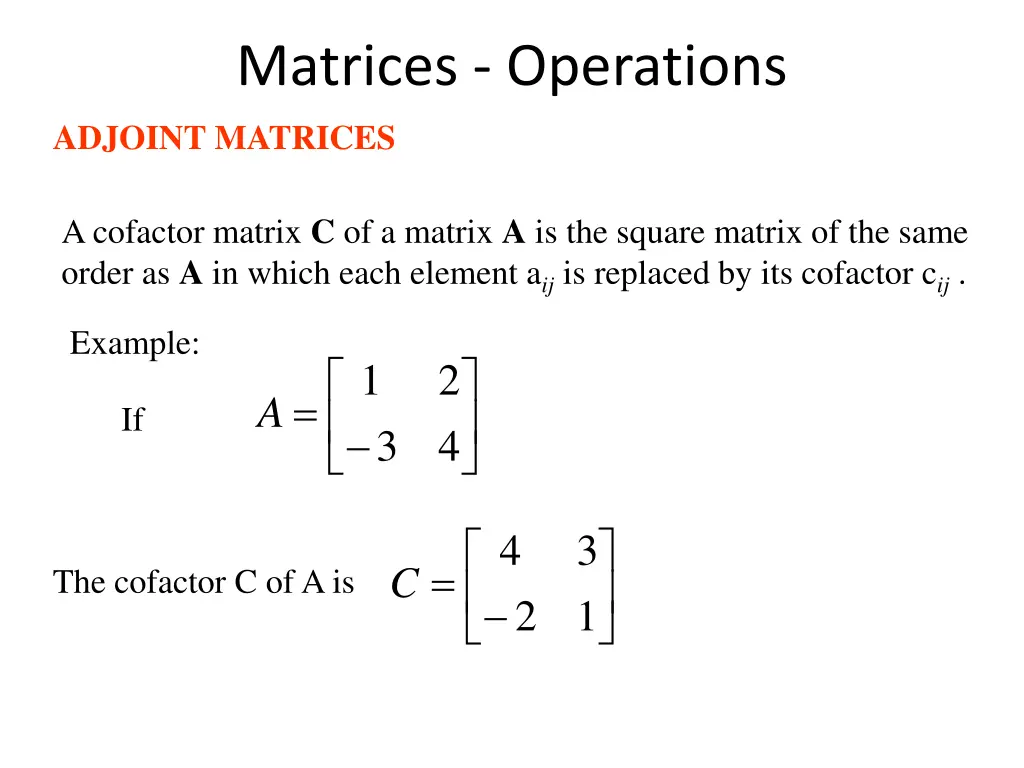
Matrix Operations: Cofactor, Adjoint, Inversion Examples
Explore matrix operations including cofactor matrices, adjoint matrices, and matrix inversion through detailed examples. Learn how to calculate determinants, cofactors, and verify matrix inverses for nonsingular matrices.
Uploaded on | 3 Views
Download Presentation

Please find below an Image/Link to download the presentation.
The content on the website is provided AS IS for your information and personal use only. It may not be sold, licensed, or shared on other websites without obtaining consent from the author. If you encounter any issues during the download, it is possible that the publisher has removed the file from their server.
You are allowed to download the files provided on this website for personal or commercial use, subject to the condition that they are used lawfully. All files are the property of their respective owners.
The content on the website is provided AS IS for your information and personal use only. It may not be sold, licensed, or shared on other websites without obtaining consent from the author.
E N D
Presentation Transcript
Matrices - Operations ADJOINT MATRICES A cofactor matrix C of a matrix A is the square matrix of the same order as A in which each element aij is replaced by its cofactor cij . Example: 1 2 = A If 3 4 4 3 = C The cofactor C of A is 2 1
Matrices - Operations The adjoint matrix of A, denoted by adj A, is the transpose of its cofactor matrix T C adjA = It can be shown that: A(adj A) = (adjA) A = |A| I Example: 1 2 = A 1 ( 2 ( 3 4 = = ) 4 )( )( ) 3 10 A 4 2 = = T adjA C 3 1
Matrices - Operations 1 2 4 2 10 0 = = = ( ) 10 A adjA I 3 4 3 1 0 10 4 2 1 2 10 0 = = = ( ) 10 adjA A I 3 1 3 4 0 10
Matrices - Operations USING THE ADJOINT MATRIX IN MATRIX INVERSION Since AA-1 = A-1A = I and A(adj A) = (adjA) A = |A| I then adjA 1 A = A
Matrices - Operations Example 1 2 A = 3 4 1 . 0 4 . 0 4 2 2 . 0 1 = = 1 A 3 1 3 . 0 10 To check AA-1 = A-1A = I 2 . 0 1 . 0 1 2 4 . 0 2 . 0 1 0 = = = 1 AA I 3 4 3 . 0 0 1 1 . 0 4 . 0 1 2 1 0 = = = 1 A A I 3 . 0 3 4 0 1
Matrices - Operations Example 2 1 3 1 1 = 2 0 A 1 2 1 The determinant of A is |A| = (3)(-1-0)-(-1)(-2-0)+(1)(4-1) = -2 The elements of the cofactor matrix are = 3 ( + = + = ), ( 1 ), ( 2 ), c c c 13 11 12 = = + = 7 ( ( 1 ), ( 4 ), ), c c c 21 22 23 = + = = 5 ( + ( 1 ), ( 2 ), ), c c c 31 32 33
Matrices - Operations The cofactor matrix is therefore 1 1 2 3 = 4 7 C 1 2 5 so 2 2 1 1 1 = = T 4 adjA C 3 7 5 and 2 2 0 . 2 1 1 1 5 . 0 5 . 0 5 . 0 1 adjA = = = 1 4 0 . 1 0 . 1 A 2 A 3 7 5 5 . 1 5 . 3 5 . 2
Matrices - Operations The result can be checked using AA-1 = A-1A = I The determinant of a matrix must not be zero for the inverse to exist as there will not be a solution Nonsingular matrices have non-zero determinants Singular matrices have zero determinants






















